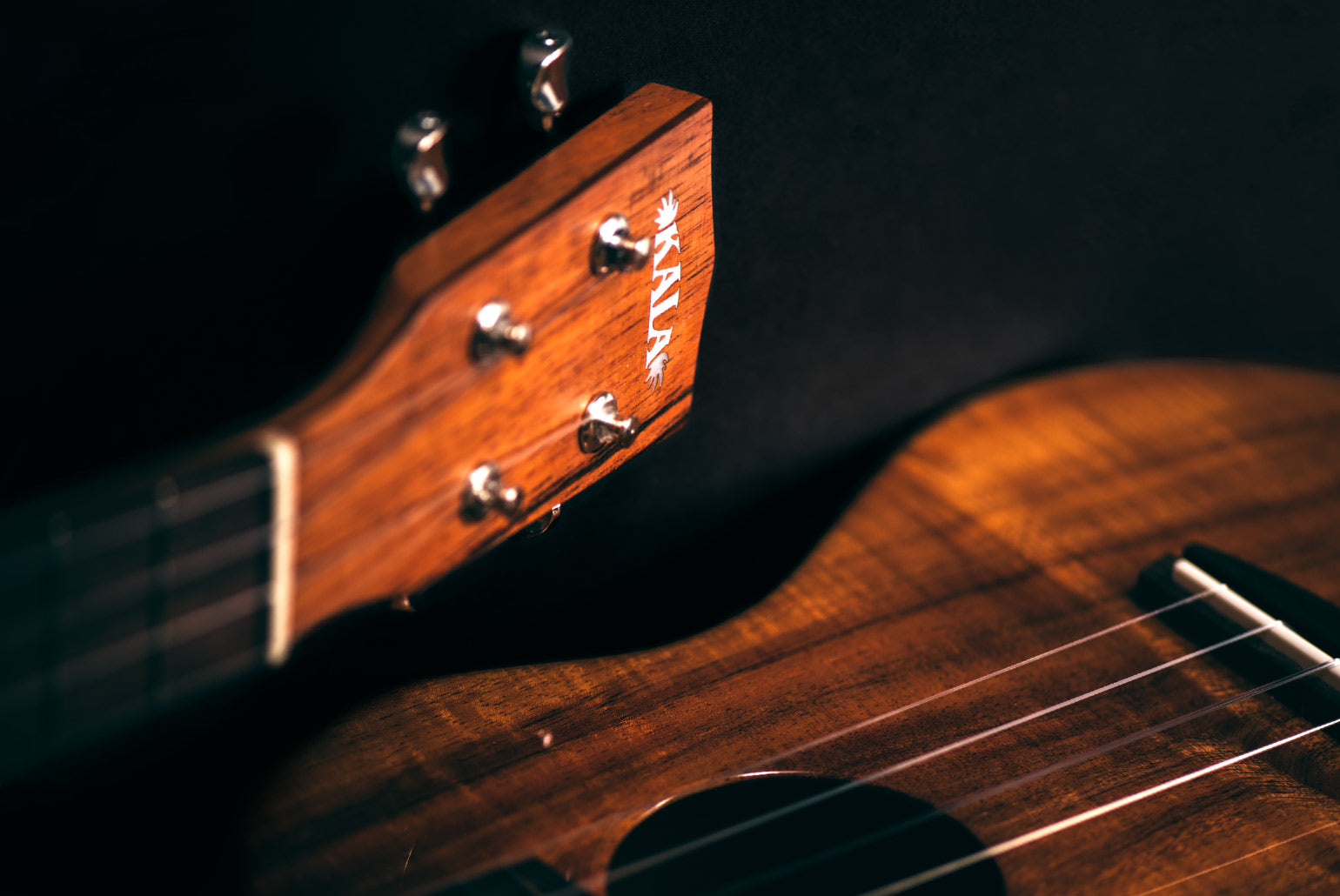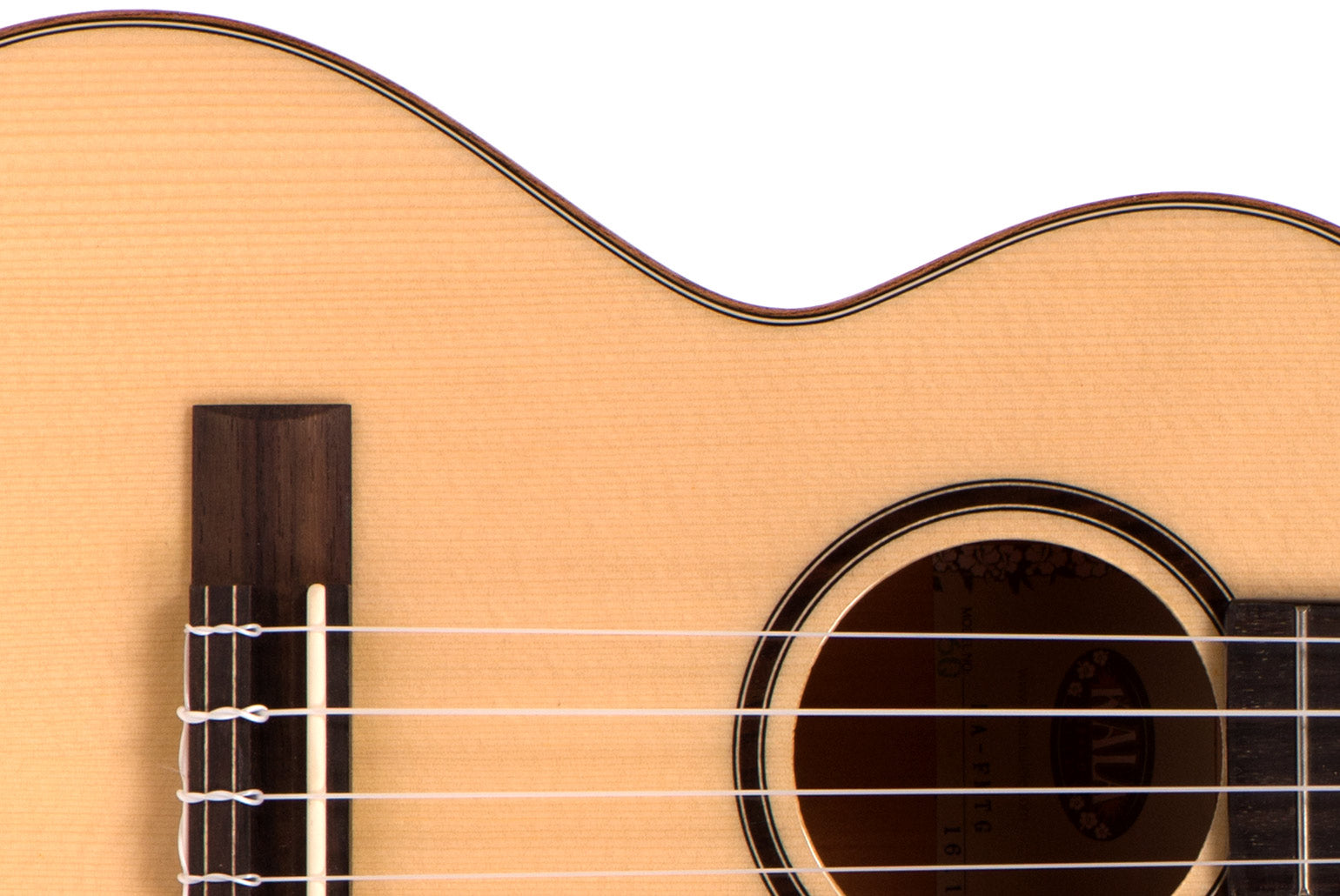
Parts Of The Ukulele
An important piece to continued enjoyment of the ukulele is knowing its parts. Knowing your uke will help you care for it and keep it in optimum working condition. We’ve used the most common names for the main parts of the ukulele and described their essential features and functions. Alternate names for parts have been listed where applicable.

Headstock: The headstock (or head) is the top part of the ukulele located at the end of the neck. The tuners are attached to the headstock. A headstock can be solid or slotted which seems to be a matter of aesthetic preference with no detectable effect on the ukulele’s tone.
Tuners: The tuners are located on the headstock of the ukulele and hold the strings in place. The number of tuners corresponds to the number of strings the ukulele has, usually between four and eight. You twist the tuners individually to tune the strings. [Also called pegs, tuning pegs, tuning keys, tuning heads, or machine heads.]
Nut: The nut is located at the end of the fretboard, where the headstock and neck of the ukulele meet. The nut (along with the saddle at the body) has small notches that hold the strings in their proper place at the neck.
Fretboard: The fretboard runs the length of the neck on the front of the ukulele. The fretboard is where the frets of the ukulele are located. You press the strings against the fretboard to create a note or chord when playing the ukulele. Many fretboards have inlaid fret markers (usually dots) at intervals up the neck to help you find your away around the fretboard. Kala ukes have fret markers at the fifth, seventh, and tenth frets on soprano size and fifth, seventh, tenth, and twelfth frets on concert, tenor, and baritone sizes.
Frets: The frets are the strips of metal that stick out and run vertically up and down the fretboard. The frets mark the different pitches of notes. Fretless instruments may or may not have lines on the fretboard where the frets would normally be.
Fret Space: The fret space is where you press the strings against the fretboard so the strings lay against the fret in order to form a note or chord.
Body: The body of the ukulele is the largest part of the ukulele where sound is produced by amplifying the vibration of the strings when strummed or plucked. The body is made up of three parts: the top or soundboard, the back, and the sides. The body can be made of solid or laminate wood and different woods used for these three parts create different tones. The body comes in different shapes and sizes and may include a cutaway or scallop in order to reach the higher frets on the fretboard.
Strings: The strings of the ukulele are what you pluck or strum to create the vibrations that are sent through the sound hole to make the ukulele’s sound. Soprano and Concert ukulele are usually strung with nylon strings. Tenor and Baritone ukulele often use a mixture of nylon and metal-wound strings. Metal-wound strings are used to add a fullness to the tone of the lower pitch strings. The most common ukulele tuning for Soprano and Concert sizes is G-C-E-A (reentrant tuning). Reentrant tuning means that the strings don’t run in sequence from low to high as you move through them. They have a break in the sequence, in this case the High G string (the second highest string) coming before the lowest string - C. The most common tuning for Tenor size is also G-C-E-A, but a metal-wound Low G is often substituted for the nylon High G. The most common tuning for Baritone size is D-G-B-E, like the four highest strings on a guitar.
Saddle: The saddle sits on top of the bridge and hold the strings in place at the body of the ukulele (like the nut at the neck). The saddle holds the strings in place at the body and is raised to keep the strings the proper distance from the fretboard.
Bridge: The bridge is mounted on the top of the body of the ukulele just below the sound hole with a saddle mounted on top of it. The bridge is where you will secure the strings at the body of the ukulele, usually done by knotting one end of the string.
Neck: The neck of the ukulele connects the body to the headstock and holds the fretboard on top of it. The neck is curved to allow hands to cup the neck comfortably. The neck is usually made of one solid piece of wood to give it strength to support the tension of the strings. The neck and headstock are often made together from a single piece of wood.
Sound Hole: Located on the body of the ukulele just underneath the strings, the sound hole projects the sound that reverberates inside the body of the ukulele. Strumming or plucking the strings directly above the sound hole produces the loudest sound, whereas moving away from the sound hole up the neck or down the body reduces the sound. Some sound holes have a pattern inlaid into the wood surrounding them called a rosette.
Tuners: The tuners are located on the headstock of the ukulele and hold the strings in place. The number of tuners corresponds to the number of strings the ukulele has, usually between four and eight. You twist the tuners individually to tune the strings. [Also called pegs, tuning pegs, tuning keys, tuning heads, or machine heads.]
Nut: The nut is located at the end of the fretboard, where the headstock and neck of the ukulele meet. The nut (along with the saddle at the body) has small notches that hold the strings in their proper place at the neck.
Fretboard: The fretboard runs the length of the neck on the front of the ukulele. The fretboard is where the frets of the ukulele are located. You press the strings against the fretboard to create a note or chord when playing the ukulele. Many fretboards have inlaid fret markers (usually dots) at intervals up the neck to help you find your away around the fretboard. Kala ukes have fret markers at the fifth, seventh, and tenth frets on soprano size and fifth, seventh, tenth, and twelfth frets on concert, tenor, and baritone sizes.
Frets: The frets are the strips of metal that stick out and run vertically up and down the fretboard. The frets mark the different pitches of notes. Fretless instruments may or may not have lines on the fretboard where the frets would normally be.
Fret Space: The fret space is where you press the strings against the fretboard so the strings lay against the fret in order to form a note or chord.
Body: The body of the ukulele is the largest part of the ukulele where sound is produced by amplifying the vibration of the strings when strummed or plucked. The body is made up of three parts: the top or soundboard, the back, and the sides. The body can be made of solid or laminate wood and different woods used for these three parts create different tones. The body comes in different shapes and sizes and may include a cutaway or scallop in order to reach the higher frets on the fretboard.
Strings: The strings of the ukulele are what you pluck or strum to create the vibrations that are sent through the sound hole to make the ukulele’s sound. Soprano and Concert ukulele are usually strung with nylon strings. Tenor and Baritone ukulele often use a mixture of nylon and metal-wound strings. Metal-wound strings are used to add a fullness to the tone of the lower pitch strings. The most common ukulele tuning for Soprano and Concert sizes is G-C-E-A (reentrant tuning). Reentrant tuning means that the strings don’t run in sequence from low to high as you move through them. They have a break in the sequence, in this case the High G string (the second highest string) coming before the lowest string - C. The most common tuning for Tenor size is also G-C-E-A, but a metal-wound Low G is often substituted for the nylon High G. The most common tuning for Baritone size is D-G-B-E, like the four highest strings on a guitar.
Saddle: The saddle sits on top of the bridge and hold the strings in place at the body of the ukulele (like the nut at the neck). The saddle holds the strings in place at the body and is raised to keep the strings the proper distance from the fretboard.
Bridge: The bridge is mounted on the top of the body of the ukulele just below the sound hole with a saddle mounted on top of it. The bridge is where you will secure the strings at the body of the ukulele, usually done by knotting one end of the string.
Neck: The neck of the ukulele connects the body to the headstock and holds the fretboard on top of it. The neck is curved to allow hands to cup the neck comfortably. The neck is usually made of one solid piece of wood to give it strength to support the tension of the strings. The neck and headstock are often made together from a single piece of wood.
Sound Hole: Located on the body of the ukulele just underneath the strings, the sound hole projects the sound that reverberates inside the body of the ukulele. Strumming or plucking the strings directly above the sound hole produces the loudest sound, whereas moving away from the sound hole up the neck or down the body reduces the sound. Some sound holes have a pattern inlaid into the wood surrounding them called a rosette.

Now that you're more familiar with the parts of the ukulele and what they do you should be able to better care for your uke, communicate more effectively with others, and be more prepared to describe and troubleshoot any issues. If you're still looking for more information on ukulele parts, then check out Live Ukulele's detailed parts guide.
What do you look for in an ukulele? Anything specific that you have to have? Let us know in the comments.
